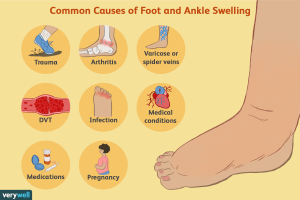Understanding Ankle Swelling
Ankle swelling, medically termed “edema,” occurs when there is an accumulation of fluid in the tissues around the ankle joint. This condition can be uncomfortable and sometimes indicative of underlying health issues. Understanding the causes, symptoms, and potential treatments for ankle swelling is crucial for managing this condition effectively. Explore More About Health Problems And Their Solutions (Which Disease Usually Begins First)
Causes of Ankle Swelling
Several factors can contribute to ankle swelling. It’s essential to recognize these causes to address the root issue effectively.
1. Dietary Factors
Salt Intake: High sodium consumption can lead to water retention in the body, contributing to ankle swelling. Processed foods, canned soups, and snacks often contain excessive amounts of salt.
Dehydration: Inadequate water intake can cause the body to retain sodium, leading to swelling in various parts, including the ankles.
2. Lifestyle Choices
Sedentary Lifestyle: Lack of physical activity can impede blood circulation, causing fluid buildup in the ankles.
Prolonged Standing or Sitting: Remaining in one position for extended periods can hinder proper blood flow, leading to ankle swelling.
3. Medical Conditions
Venous Insufficiency: This condition occurs when the veins in the legs have difficulty returning blood to the heart, leading to swelling in the ankles and legs.
Heart Failure: In cases of heart failure, the heart may not pump blood effectively, causing fluid buildup in the body, including the ankles.
Kidney Disease: Impaired kidney function can result in fluid retention, leading to swelling in various parts of the body, including the ankles.

Symptoms of Ankle Swelling
Recognizing the symptoms of ankle swelling can help in timely intervention and management of the condition.
1. Visible Swelling
An obvious symptom is the visible enlargement of the ankle, often accompanied by a feeling of tightness or heaviness in the affected area.
2. Pitting Edema
Pressing a finger into the swollen area may leave an indentation or “pit” that remains for a few seconds before disappearing, indicating pitting edema.
3. Restricted Movement
Severe swelling can restrict movement and cause discomfort while walking or standing for prolonged periods.
Treatment and Prevention
Managing ankle swelling involves addressing underlying causes and implementing preventive measures.
1. Dietary Modifications
Reducing Sodium Intake: Limiting the consumption of processed and salty foods can help decrease fluid retention in the body.
Increasing Water Consumption: Staying adequately hydrated can prevent water retention and promote proper fluid balance.
2. Lifestyle Adjustments
Regular Exercise: Engaging in physical activity improves blood circulation and reduces the risk of swelling.
Avoiding Prolonged Sitting or Standing: Taking breaks and changing positions frequently can prevent fluid buildup in the ankles.
3. Medical Intervention
Compression Therapy: Wearing compression stockings or bandages can help reduce swelling by promoting venous return.
Medications: In some cases, diuretics may be prescribed to help the body eliminate excess fluid.

When to Seek Medical Attention
While mild ankle swelling may resolve with lifestyle changes, certain situations warrant medical evaluation:
- Sudden and severe swelling without apparent cause
- Swelling accompanied by pain, redness, or warmth
- Swelling persisting despite home remedies
- Swelling occurring after an injury or trauma
Prompt medical attention is crucial to rule out serious underlying conditions and prevent complications.
Dietary Factors vs. Lifestyle Choices vs. Medical Conditions
| Factors | Dietary Factors | Lifestyle Choices | Medical Conditions |
|---|---|---|---|
| Salt Intake | High sodium consumption | Sedentary Lifestyle | Venous Insufficiency |
| Dehydration | Inadequate water intake | Prolonged Standing or Sitting | Heart Failure |
| Kidney Disease |
Conclusion
Ankle swelling can result from various factors, including dietary habits, lifestyle choices, and underlying health conditions. Understanding the causes, symptoms, and treatment options is essential for effectively managing this condition. By making appropriate lifestyle modifications and seeking medical advice when necessary, individuals can alleviate discomfort and maintain optimal ankle health. Remember, proactive measures and timely intervention are key to demystifying ankle swelling and promoting overall well-being.




